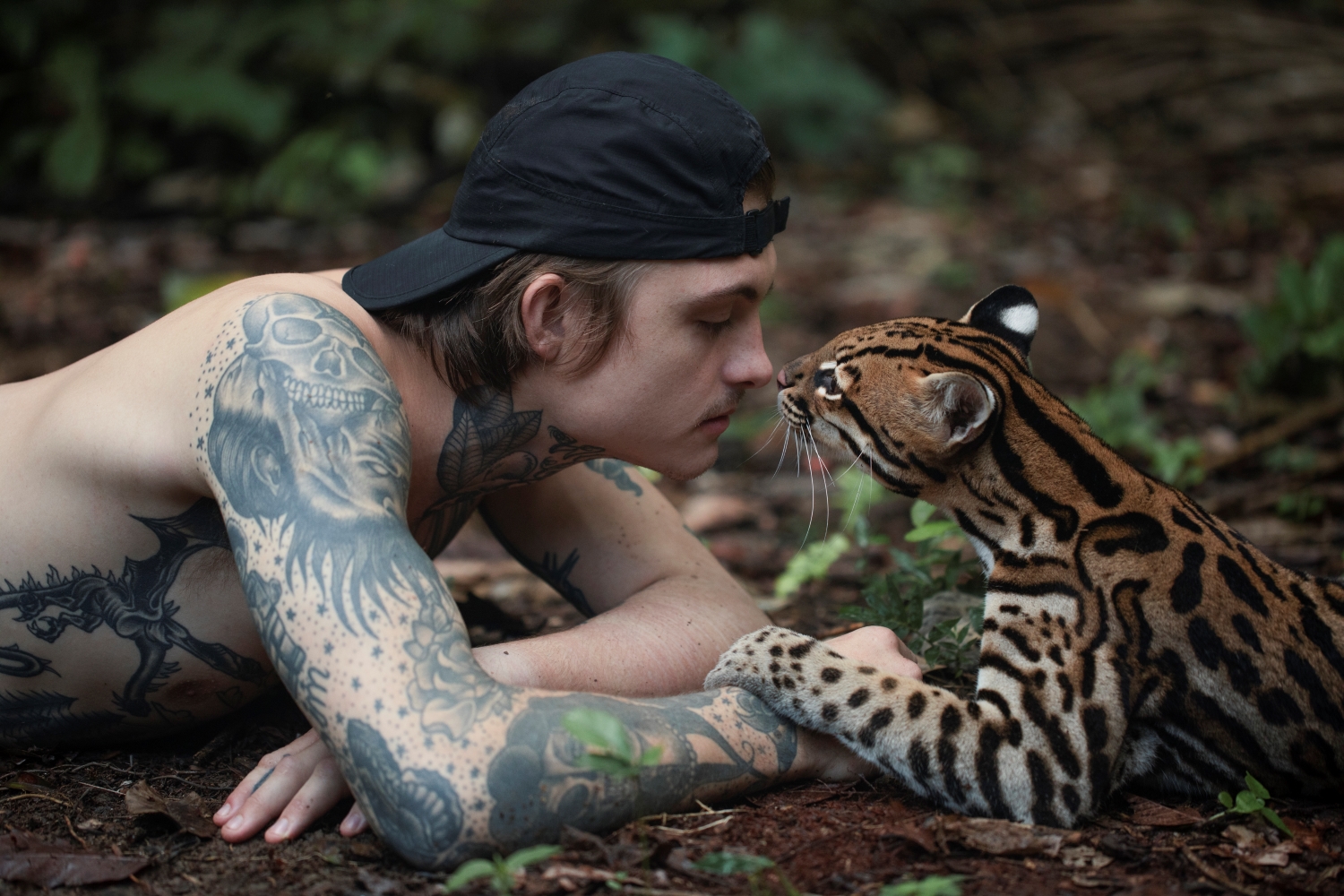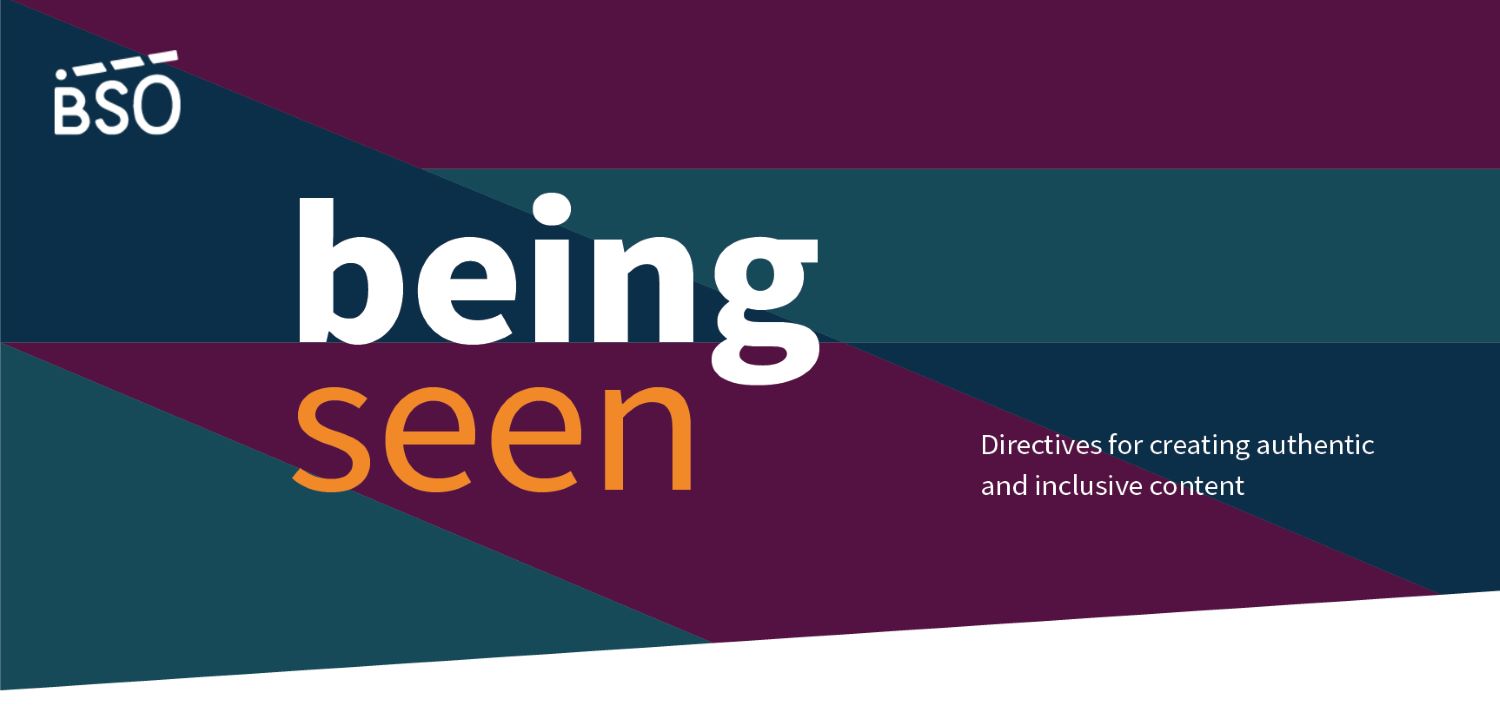“We come from a conservation background and both Harry and Sam obviously are very interested in conservation,” Wildcat director Trevor Frost tells POV via Zoom. “Their work is relatively new. If they film everything, they have a record that will allow them to not only improve the work that they’re doing moving forward, but also to be able to share it with other people who are going to end up doing this work.”
Wildcat, which Frost directs with Melissa Lesh, follows Brit Harry Turner and American Samantha Zwicker as they forge new efforts in the Peruvian Amazon to reintroduce animals to the wild. In particular, Wildcat observes Harry’s close relationship with two ocelots, Khan and Keanu, as he raises them from kittens and teaches them to adapt to the wild. Fans of Kedi are certainly in for an epic cat movie with the footage the Wildcat delivers, but should prepare for the dark and necessary places the film explores within the human characters’ psyche.
These cats rescue Harry as much as he helps them. As a veteran of the war in Afghanistan who live with depression and PTSD, Harry’s work with the ocelots allows him to slow down and recalibrate. However, the world that Harry tries to escape inevitably interrupts his idyll Amazonian oasis, sometimes quite dramatically. Loggers and poachers exploit the very wildlife he seeks to protect, in turn triggering his traumatic memories of the field. Through Harry and Samantha’s effort to restore these cats to their natural habitats, Wildcat captures the raw daily struggle of finding balance in world hurtling towards self-destruction.
“This work will become increasingly important to restore ecosystems, especially 50 years from now when we realize the fallout and the mistakes that we’ve made, and we realize that we have no choice but to restore some of these places,” observes Frost. “The ability to reintroduce cats and to reintroduce other animals is going to be critical. That informed a lot of what Harry chose to film and that certainly was what we were interested in as well. Melissa and I are very attached to conservation.”
POV spoke with Wildcat director Trevor Frost ahead of the film’s theatrical release in the USA and debut on Prime Video.
POV: Pat Mullen
TF: Trevor Frost
This interview has been edited for brevity and clarity.
POV: Wildcat has such amazing footage of the cats. How did you film Khan and Keanu without building a relationship that would affect their reintroduction to the wild?
TF: Harry had filmed everything with Khan and Samantha filmed a lot with Khan as well. When we saw that footage that they had filmed with Khan, we knew immediately that the two of them were great with cameras. They understood when to keep recording. I think a lot of people have a tendency to put cameras down when things get difficult, and the fact that they didn’t really struck the chord with us. We came onto the scene when Keanu came into their lives.
We wanted to continue that on that path. But they had very strict rules around who could actually be around Keanu. They’re really at the beginning of their work in rewilding carnivores and, in particular, these small cats, so they’re learning a lot and they made a lot of mistakes [when the film begins]. But they knew they didn’t want any other humans around Keanu other than Harry. Samantha was around Keanu when he was very young, and they did the filming together when Keanu was younger than three months. After three months of age, Harry was the only person who had access to Keanu until he was released. When he was released, I saw Keanu on probably four or five occasions, but almost all of the footage that you see of Keanu in the film is filmed by Harry. 40-plus percent of the film is actually filmed by Harry and Samantha.
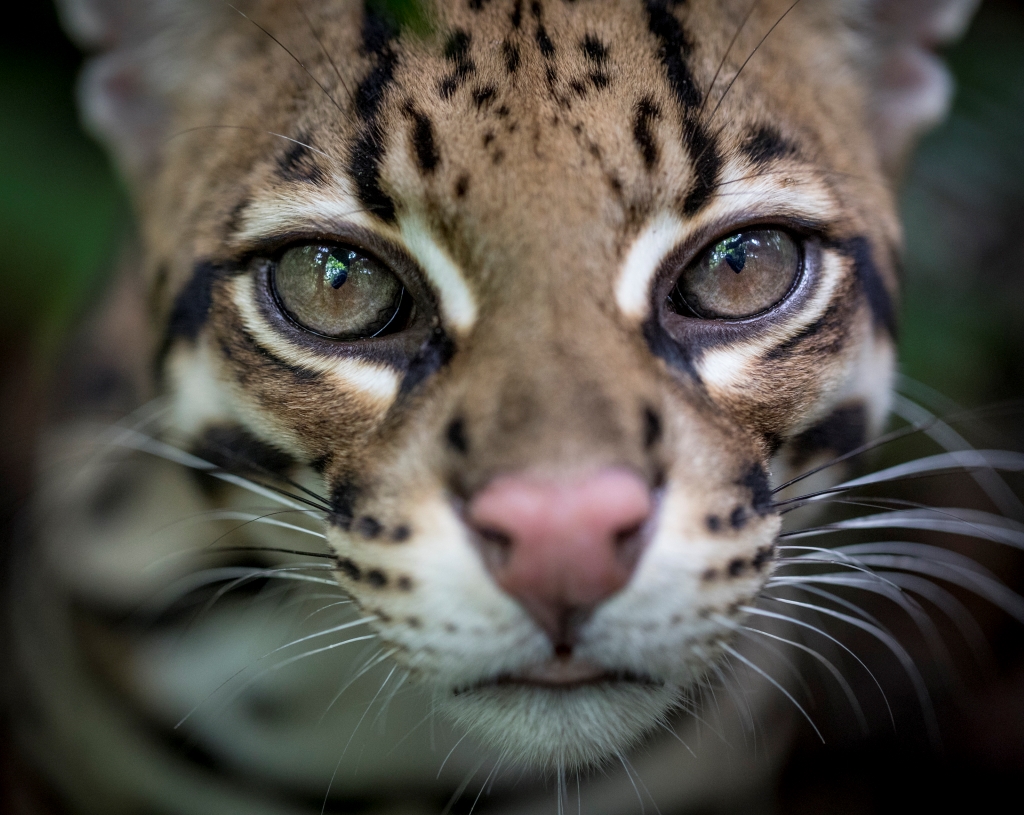
POV: How much did you know about Harry’s mental health when you took on the story, and what was the conversation with him to make that an equal part of the story?
TF: When I met Harry, he was not in a great place when he showed me all of the archival material that he and Samantha had filmed together. I was taken by it and it was clear to me that Harry was really struggling [due to an expected loss]. Towards the end of Keanu’s re-reintroduction process, Harry’s mental health started to decline in a very serious way. We always knew that it was going to be a part of the film, but when we started the film, there was certainly much more of a veteran-saved-by-the-rainforest type of story. I still stand by the fact that the rainforest, Khan, and Keanu saved Harry’s life. They gave him a strong foundation, and it’s something that he’s very proud of having done, but we obviously see that even though the rainforest saved his life, he still struggles.
We wanted to keep telling the story when these things were revealed to us, including Samantha’s own backstory, which was equally important, because that is the reality of mental health. It is not something that goes away in your lifetime unless there’s some radical breakthrough. Speaking personally as someone who struggles with depression and anxiety, I know how it is to have periods where, even when things are going really well, I have really bad days. Sometimes there are days where I can’t get out of bed or days where all I can do is watch movies and I get nothing done. It’s this very dangerous cyclical thing because you’re not getting out of bed and you’re not doing anything. We have such an attachment to productivity in our culture that it’s very easy to be caught in this cycle of feeling bad.
We knew that showing Harry continuing to struggle was an incredibly real and raw portrayal of mental health, versus it being, “These cats save his life and everything’s great.” It was something that we embraced as it happened. There were points though where things did get pretty rough. There were moments when the camera was put down and we focused entirely on Harry’s wellbeing.
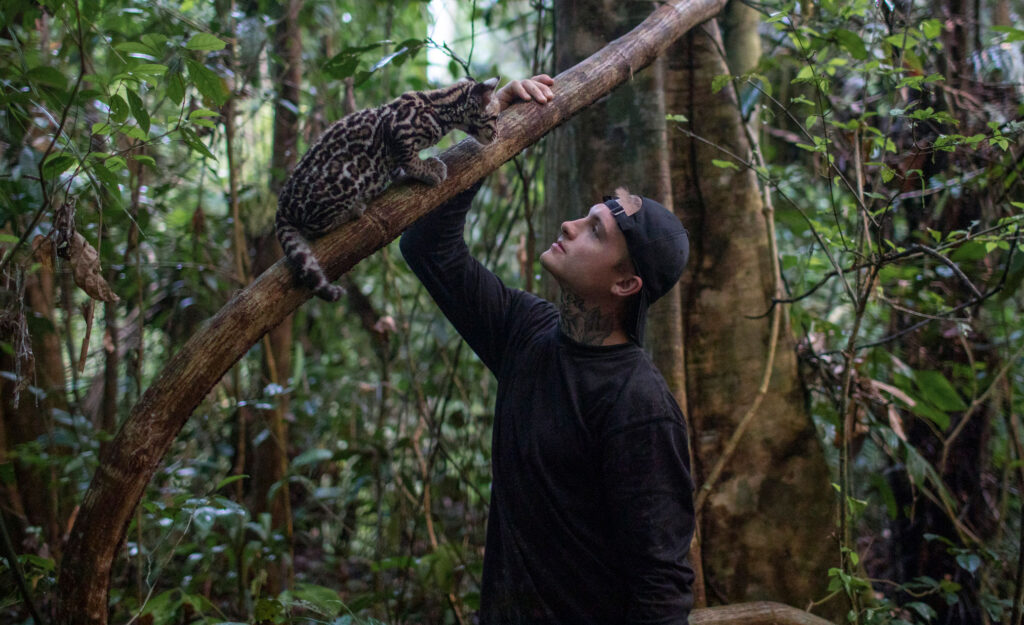
POV: Wildcat has a collaborative approach in that Harry’s a subject of the film, but he’s also actively shooting it. This is something we’re seeing a lot more in documentary, even this year with films like The Territory and All the Beauty and the Bloodshed. Where do you see the relationship between collaboration with subjects and the “objectivity” of documentary?
TF: In In our case, we didn’t have a choice because of their protocols around Keanu. Since Keanu was one of our main characters, there was no other way around it. One of the things that we wanted Harry to continue doing, which we saw glimpses of in the archive, was to do video diaries updating us on how he’s feeling. We see moments in the film where he’s really struggling and he’s actually filming himself.
It’s interesting to see people telling their own stories and what they choose to film. It’s something that I think we’re going to see more and more people embracing moving forward. Some people, I think, really tie documentary to journalism. I come from a journalism background as a still photographer. I did a lot of work for National Geographic, the Washington Post, and the New York Times. The fact checking processes that you go through and the rigour that they have in place is very different from the documentary film world where, when you’re editing a film, people take liberties of moving things around in time.
When you’re writing an article for the New York Times, you can’t really do that. You really have to spell things out as they happened. The documentary world has some relationship with journalism, but I think that it’s not as attached as some people care to admit. I also think it depends on the subject matter. If you are documenting a political event, you might have more of an obligation to follow very rigorous journalistic standards. In more personal stories, like this one, it actually can really benefit the film. The question with Wildcat was, “How can we enhance what they’re doing? How can we make it better and stronger and even more valuable to the film?” It was never really a creative choice.
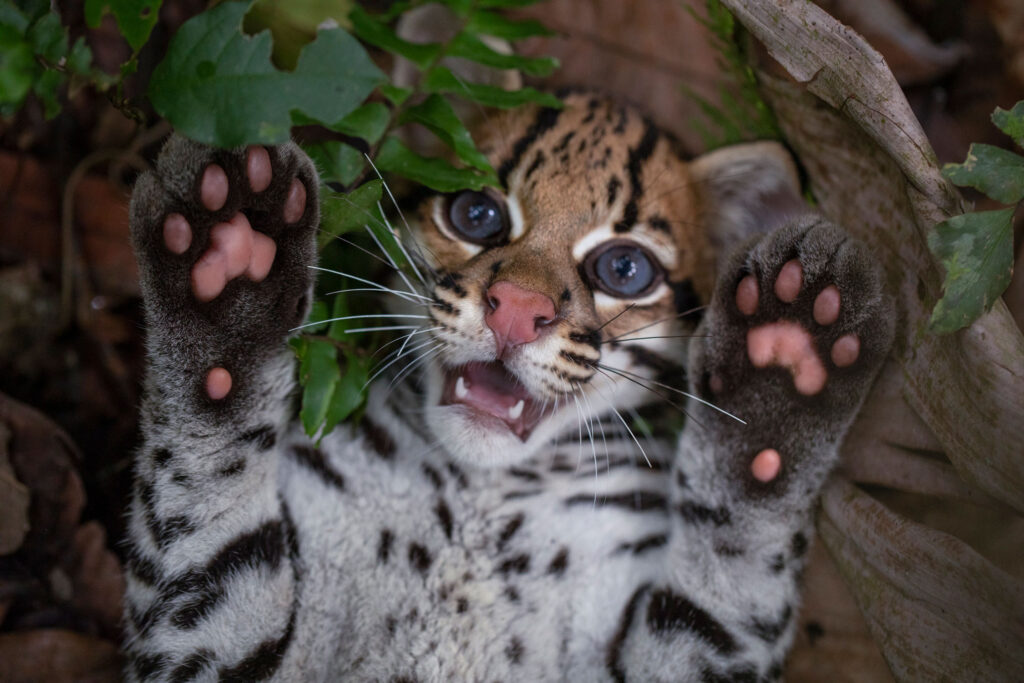
POV: I’m a cat person, but I like how Wildcat didn’t take the cute cat approach. What direction did you give Harry in terms of how to film the cats?
TF: The biggest thing that we worked on with Harry was how to film scenes. It was important that he understood how to film a scene, so that everything had a beginning, a middle, and an end so that we could use his footage as standalone scenes, or work them into footage that we were filming. For example, when we see Keanu released out of his enclosure for the first time, all of the footage that Harry shot mended very well with the footage that I was shooting at the same time when Harry came back to the platform. We were able to build very cohesive scenes. Harry was much more interested in the behaviours and teaching Keanu how to hunt and what he’s learning scientifically from spending time with a cat in the wild.
POV: What was the team’s overall relationship with the Peruvian community on the film?
TF: There was really only one community that lives near where Harry and Samantha were based. It’s about an hour by river, so it’s a small village, if you will. Harry and Sam had great relationships with that community, and Samantha still works with that community. A majority of the animals that she rescues are passing through that community. That community is now turning over a lot of the animals that come through there to her. She works very closely with the Peruvian government, both locally and nationally to rescue animals, so the relationship with that community is fantastic.
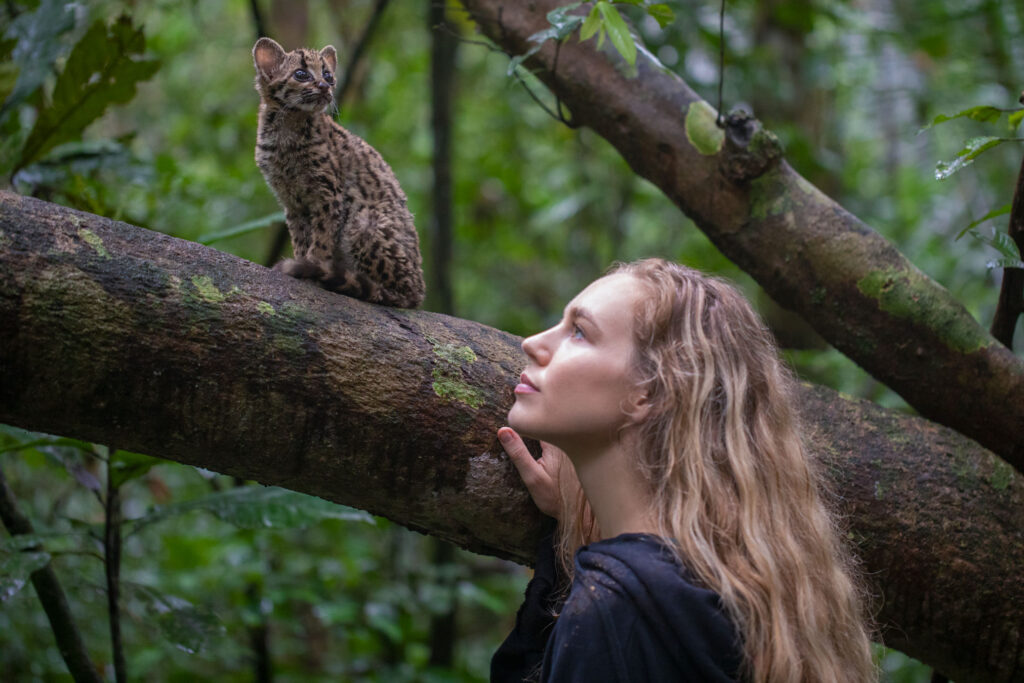
The only other community that’s on that river is about a two-day trip up river. It’s actually land that you can’t visit because there are Indigenous people who are uncontacted. No one is allowed to go in there. For the most part, the locals in that area are people who are logging or collecting Brazil nuts. There are some local farmers, so you don’t run into a ton of people, but certainly the people that you do run into, had great relationships with them. At one point, we were very interested in incorporating the story of one of the people who worked very closely with them on a lot of their projects. He helped them build a lot of the enclosures and the platforms that they lived on. He had an interesting backstory where he lost touch with his family—they didn’t want anything to do with him because of mistakes that he made when he was younger. He was an illegal logger and now he’s helping them with their conservation work. He had a similar backstory to Harry and Sam, so we thought there was a great opportunity to incorporate his story into the film, but unfortunately, things fell apart for several reasons. He obviously could make more money doing logging than he could in conservation. He had a young family that he had to take care of, so we never got the opportunity to follow that story to fruition.
Everyone [at the wildlife centre,] is Peruvian except for Samantha and her partner, Dylan. They have two veterinarians who are Peruvian who work full-time at the center. Sam has probably around 70 animals now in total. 20 of those are cats at various stages of reintroduction, including a jaguar, so it’s a strong Peruvian team and it’s both a U.S. non-profit and a Peruvian non-profit. They’ve always had a great relationship with everybody on the river, but we just chose not to tell that part of the story because we were laser-focused on the story of these two people who have this trauma and we follow their journey of trying to figure out how to live with it.
POV: What are some of the ways you show the macro/micro?
TF: We don’t criticize the local people. When that [old growth] tree is cut down, Samantha says, “It’s not their fault. They’re just trying to make a living.” That was the consensus, over and over again from Harry and Sam. Was it sad that the tree was cut down? Yeah, it was sad and it was devastating to see a thousand-year-old tree cut down. If you saw an animal that was taken from the wild, it’s always a difficult thing to witness and experience, but not once did either one of them blame the locals. In fact, there was a very powerful moment that we didn’t include in the film where we went to a recently burned section of forest and we were finding dead animals that burned in the fire. Harry was picking them all up. He’s standing there and there’s smoke rising all around him and he says, “I’m not mad at these people. They’re just trying to survive. I guess I’m just mad at the world.” I thought that was a good way of putting it because the world is a very unfair place and there’s obviously a lot of people who have more than they need. Then there are people who are just trying to survive, so how can you actually be mad at them?
POV: How does following a story with a feature documentary differ in terms of your work as a photographer? How does the longevity of being immersed with the subjects shape your way of looking at them?
TF: It was very different process, for sure. At least from my experience, you become much more entwined with the project than you do in still photography. Plenty of still photographers are photographing very difficult subject matter and see some difficult things. If you’re a war photographer, you obviously see some awful stuff, but in photography, you take the picture and, for the most part, you’re done. Whereas in film, in order for the scene to communicate, you have to film an entire scene. You have to film multiple angles. You have to get audio. All of these things are important. It naturally requires a more intense immersion into the thing that you’re trying to document.
If I was telling this as a photo story, I have no doubt that I would’ve not gotten as enmeshed in the entire project. I wouldn’t have become as close to Harry and Samantha as I became. I also, frankly, probably wouldn’t have gotten as hurt as I did because there were some very difficult moments. There are plenty more that aren’t on camera because we put the cameras down. It’s something that we as filmmakers, and as just as people, weren’t prepared for. I talk about this a lot: society teaches us math and science and reading comprehension, but when you’re a young kid, no one’s teaching you how to deal with grief or how to deal with conflict resolution or how to deal with a friend who’s struggling with suicidal thoughts.
What would the world look like if we started to learn that from a young age—how to handle all of these things so that all of us were better prepared for dealing with these things that are inevitable in life? How do you handle loss? When you lose your first pet, it’s instead like this unexpected smack in the face. You just have to figure it out.




